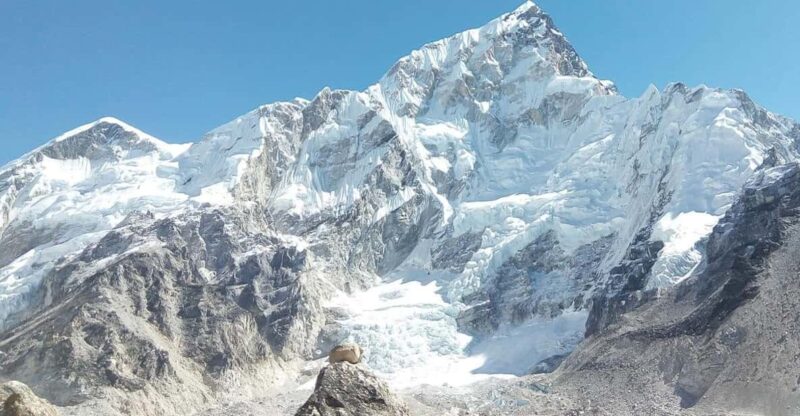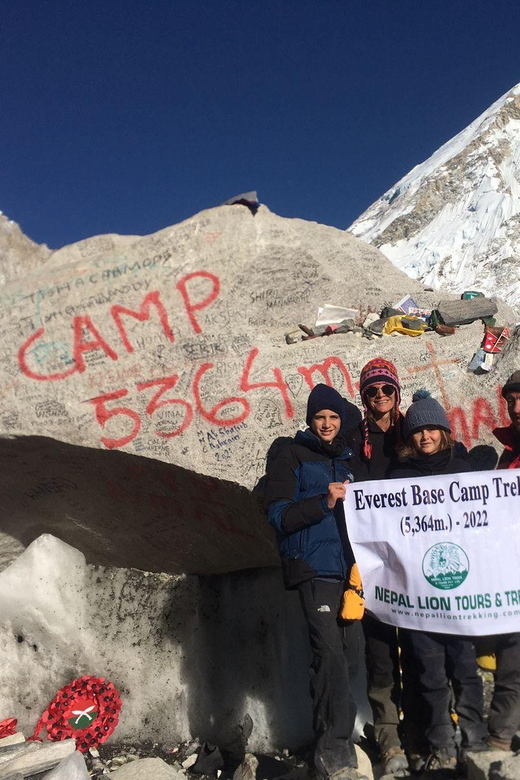The Everest Base Camp Tour presents a unique opportunity for trekkers to enjoy the majestic landscapes of Nepal’s Khumbu region. Covering over 130 kilometers, this 12-day journey combines daily hikes and cultural encounters, ensuring a balanced experience of adventure and personal growth. Participants ascend to an impressive altitude of 5,554 meters, where they can witness breathtaking views and engage with the Sherpa community. With varying trekking options, it accommodates diverse preferences and skill levels. What essential preparations should one consider to make the most of this remarkable adventure?
This experience made our list of the 4 Best Tours In Namche Bazar.
Key Points

- The Everest Base Camp Tour is a 12-day trek through Nepal’s Khumbu region, reaching altitudes up to 5,554 meters.
- The journey includes key stops at Namche Bazaar, Tengboche, and acclimatization days in Dingboche and Lobuche.
- Package costs range from $1,200 to $2,500, covering flights, meals, accommodations, and a licensed guide.
- Proper acclimatization, hydration, and packing essentials like sturdy footwear are crucial for a safe trekking experience.
- Cultural interactions with Sherpas and visits to sacred sites enrich the trekking experience, providing insights into local traditions.
Tour Overview

The Everest Base Camp trek offers adventurers a thrilling 12-day journey through Nepal’s Khumbu region, where they can experience breathtaking landscapes and rich Sherpa culture while reaching an impressive altitude of 5,554 meters.
Covering over 130 kilometers, trekkers traverse dense forests, charming villages, and stunning mountain vistas. The trek incorporates acclimatization stops, ensuring safety and comfort as participants adapt to the altitude.
Highlights include interactions with local Sherpas, visits to the iconic Tengboche Monastery, and sweeping views from Kala Patthar. Each day presents unique challenges and rewards, making the trek not just a physical journey but also a culture into the heart of the Himalayas.
Adventurers leave with memories that last a lifetime, having embraced both nature and heritage.
You can also read our reviews of more tours and experiences in Namche Bazar.
Detailed Itinerary
Curious about the journey ahead, trekkers can look forward to a meticulously planned itinerary that guides them through the stunning landscapes and vibrant culture of the Khumbu region.
The adventure kicks off with a scenic flight to Lukla, followed by a trek through iconic spots like Namche Bazaar and Tengboche. Each day involves about six hours of hiking, with designated acclimatization stops in Dingboche and Lobuche.
Trekkers spend a memorable day at Everest Base Camp, soaking in the breathtaking views, before heading back to Lukla. The itinerary ensures ample opportunities for cultural experiences, showcasing the rich Sherpa heritage, while maintaining a steady pace for acclimatization and enjoyment.
Each moment promises to be unforgettable on this remarkable trek.
Cost Breakdown
Understanding the costs involved in the Everest Base Camp trek helps trekkers plan their adventure effectively and ensures they’ve an unforgettable experience without unexpected financial surprises.
The total cost typically varies based on several factors, including trek duration, season, and level of comfort. A standard package can range from $1,200 to $2,500, covering essential expenses such as airport transfers, flights to Lukla, meals, accommodations, and a licensed guide.
Trekkers should also budget for permits, tips, and personal expenses. It’s essential to research and compare different tour operators to find the best value while ensuring quality service.
Inclusions and Exclusions
Inclusions for the Everest Base Camp trek cover essential services that ensure a smooth and enjoyable journey, allowing trekkers to focus on the breathtaking landscapes and cultural experiences without worrying about logistical details.
The package typically includes airport pick-up and drop-off, round-trip flights from Kathmandu to Lukla, and all meals and accommodations throughout the trek.
Trekkers also benefit from a licensed guide fluent in multiple languages, necessary permits, and a comprehensive First Aid Medical Kit.
Plus, essential trekking equipment like a down jacket, sleeping bag, duffel bag, and trekking map is provided.
However, participants should note that international airfare, visa charges, personal expenses, and emergency costs aren’t included in the package.
More Great Tours NearbyTrekking Options Available
Trekkers can choose from various options for the Everest Base Camp adventure, catering to different time constraints and comfort preferences.
For those with limited time, a short trek lasts 9-10 days, focusing on key highlights like Namche Bazaar and Tengboche Monastery. This option allows trekkers to experience the essence of the region without a lengthy commitment.
On the other hand, luxury trekking packages offer enhanced comfort, featuring deluxe accommodations and gourmet dining, ideal for those seeking a more opulent experience.
Standard treks provide a balanced approach, combining adventure with adequate support.
Whatever the choice, each option offers a unique perspective on the breathtaking landscapes and rich culture of the Everest region, ensuring an unforgettable journey.
Health and Safety Tips
Staying healthy and safe during the Everest Base Camp trek is crucial for an enjoyable experience in the challenging high-altitude environment.
Trekkers should acclimatize properly, taking rest days to allow their bodies to adjust to thinner air. Staying hydrated is essential; drinking plenty of water helps combat altitude sickness.
A balanced diet will fuel energy levels, and trekkers should carry snacks for extra sustenance. It’s wise to listen to one’s body—if symptoms like headaches or dizziness occur, descending to a lower altitude is vital.
On top of that, using proper gear, including sturdy footwear, will prevent injuries. Lastly, having a guide ensures trekkers stay informed about safety protocols and can respond quickly to emergencies, making the journey safer and more enjoyable.
Packing Essentials
Packing the right essentials is crucial for a successful Everest Base Camp trek, ensuring trekkers are prepared for the varying weather conditions and high-altitude challenges they’ll face. Essential items include layered clothing, sturdy footwear, and hydration gear. Here’s a quick reference table for must-have packing items:
| Essential Item | Purpose |
|---|---|
| Insulated Jacket | Keeps warmth in cold weather |
| Trekking Boots | Provides support and traction |
| Water Bottle | Ensures hydration on the trail |
Plus, trekking poles, a first aid kit, and sunscreen are vital for comfort and safety. By preparing smartly, trekkers can focus on the breathtaking scenery rather than worrying about inadequate gear.
Cultural Insights
Exploring the rich Sherpa culture along the Everest Base Camp trek offers trekkers unique insights into the traditions, hospitality, and daily lives of the local communities. Trekkers can enjoy various cultural experiences, including:
-
Festivals: Participating in vibrant festivals like Dashain and Tihar showcases local customs and celebrations.
-
Cuisine: Tasting traditional dishes such as momos and dal bhat introduces visitors to Sherpa flavors.
-
Monasteries: Visiting sacred sites like Tengboche Monastery allows trekkers to witness spiritual practices and rituals.
-
Craftsmanship: Observing skilled artisans at work highlights the craftsmanship of local handicrafts and textiles.
These experiences enrich the trek, deepening trekkers’ understanding of the Sherpa way of life while fostering respect for this unique culture.
Frequently Asked Questions
What Is the Best Time to Trek to Everest Base Camp?
The best time to trek is during spring (March to May) and autumn (September to November). These seasons offer clear skies, moderate temperatures, and optimal conditions for enjoying breathtaking views and a comfortable trekking experience.
Are There Age Restrictions for Joining the Trek?
The trek has age restrictions, as participants must be under 95 years old. It’s vital for individuals to assess their physical fitness and altitude acclimatization, ensuring a safe and enjoyable experience for everyone involved.
Can I Charge My Electronic Devices During the Trek?
He can charge his electronic devices during the trek, but availability varies. Charging facilities are often limited to tea houses, so it’s wise to bring a portable charger to ensure his devices stay powered.
What Type of Fitness Level Is Required for This Trek?
The required fitness level for this trek involves moderate to high endurance. Trekkers should regularly exercise, enjoy hiking, and be prepared for long days of walking at high altitudes, ensuring a safe and enjoyable experience.
Is Travel Insurance Mandatory for the Everest Base Camp Trek?
Travel insurance isn’t mandatory, but it’s highly recommended. It covers unexpected events like trip cancellations or medical emergencies. Trekking in high altitudes can be unpredictable, so having insurance provides peace of mind for travelers.
Recap
To sum it up, the Everest Base Camp Tour promises an extraordinary journey through the majestic Khumbu region, blending adventure with cultural richness.
With careful planning, diverse trekking options, and essential health tips, participants can fully enjoy this unforgettable experience.
From the stunning views at Base Camp to meaningful interactions with the Sherpa community, this trek not only challenges the body but also enriches the soul, making it a perfect choice for any adventurous traveler.
You can check availability for your dates here:More Tours in Namche Bazar
More Tour Reviews in Namche Bazar
Not for you? Here's more nearby things to do in Namche Bazar we have reviewed
- Everest Base Camp Trek – 12 Days Guided Trek
- Lobuche Peak Climbing 2025/2026
- Everest Panorama Trek-10 Days
- Lobuche Peak Climbing with EBC TREK-18 Days
- Everest Base Camp, Cho-La Pass, and Gokyo Trek
- Guided: Everest Base Camp Trek
- Pokhara: 11-Day Everest Base Camp Trek
- Everest Base Camp Trek
- Everest: 6-Day Panorama Trek
- 12 days Everest Base Camp Trek
- 5-Day Everest Tour with Breakfast at Everest View Hotel
- 8 DAYS EVEREST PANORAMA VIEW TREK FROM KATHMANDU
